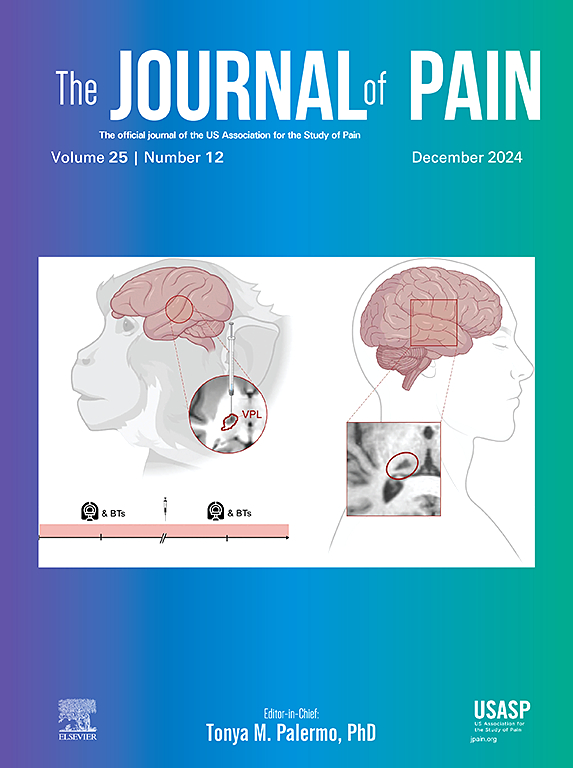Female specific interactions of serotonin and testosterone in the rostral ventromedial medulla after activity-induced muscle pain
IF 4
2区 医学
Q1 CLINICAL NEUROLOGY
引用次数: 0
Abstract
Classical preclinical studies show that serotonin (5-HT) injected into the rostral ventromedial medulla (RVM) produces analgesia that is blocked by 5-HT2 receptor antagonists. One key modulator of 5-HT activity is the serotonin transporter (SERT) which reduces serotonergic signaling through reuptake into the presynaptic terminal. In the activity-induced muscle pain model, females show widespread pain and increased SERT expression in the RVM whereas males show localized pain and no changes in SERT expression. Since prior studies show testosterone protects from the development of widespread pain, and females have widespread pain in the activity-induced pain model, we hypothesized that testosterone modulates serotonin signaling to enhance analgesia in female mice with widespread pain. We showed that testosterone reduced the enhanced SERT protein expression and increased 5-HT2A receptor mRNA expression in the RVM normally observed in the activity-induced pain model in females, but not males. Inhibition of SERT in the RVM was analgesic in both female and male mice; this analgesia was blocked by co-administration of 5-HT2A antagonist. Next, using in situ hybridization, we demonstrated co-expression of SERT, 5-HT2A receptor, and androgen receptor mRNA in cells within the RVM in female mice. Lastly, activation of androgen receptors using dihydrotestosterone reduced hyperalgesia in female mice. These data therefore show for the first time expression of androgen receptors in the RVM in female mice, that activation of androgen receptors reduces nociceptive behaviors, and endogenous testosterone modulates SERT and 5-HT2 receptor expression. Thus, we show a sex-specific role for how testosterone modulates analgesia in mice.
Perspective
This article presents novel mechanisms testosterone’s protection against muscle pain in female mice showing modulation of the serotonin system in the rostral ventromedial medulla. Understanding the relationship between testosterone and serotonin could lead to better treatment of individuals with muscle pain.
活动诱发肌肉疼痛后喙腹内侧髓质中血清素和睾酮的女性特异性相互作用
经典的临床前研究表明,将血清素(5-HT)注射到喙侧脑室内侧髓质(RVM)会产生镇痛作用,而 5-HT2 受体拮抗剂会阻断这种作用。5-HT 活性的一个关键调节器是血清素转运体(SERT),它通过再摄取进入突触前终端来减少血清素能信号传导。在活动诱导的肌肉疼痛模型中,女性表现出广泛的疼痛,RVM 中的 SERT 表达增加,而男性表现出局部疼痛,SERT 表达没有变化。由于之前的研究表明睾酮能防止广泛性疼痛的发生,而雌性小鼠在活动诱导的疼痛模型中会出现广泛性疼痛,因此我们假设睾酮能调节血清素信号转导,从而增强广泛性疼痛雌性小鼠的镇痛效果。我们的研究表明,睾酮能降低活动诱导疼痛模型中雌性小鼠RVM中正常观察到的SERT蛋白表达增强和5-HT2A受体mRNA表达增加,而雄性小鼠则不能。抑制 RVM 中的 SERT 对雌性和雄性小鼠都有镇痛作用;同时使用 5-HT2A 拮抗剂可阻断这种镇痛作用。接着,我们利用原位杂交技术证明了雌性小鼠 RVM 细胞中 SERT、5-HT2A 受体和雄激素受体 mRNA 的共同表达。最后,使用双氢睾酮激活雄激素受体可减轻雌性小鼠的痛觉减退。因此,这些数据首次显示了雄激素受体在雌性小鼠RVM中的表达,雄激素受体的激活可减少痛觉行为,内源性睾酮可调节SERT和5-HT2受体的表达。因此,我们展示了睾酮如何调节雌性小鼠镇痛的性别特异性作用。观点:本文介绍了睾酮保护雌性小鼠免受肌肉疼痛的新机制,显示了雌性小鼠喙腹外侧髓质中5-羟色胺系统的调节作用。了解睾酮与血清素之间的关系有助于更好地治疗肌肉疼痛患者。
本文章由计算机程序翻译,如有差异,请以英文原文为准。
求助全文
约1分钟内获得全文
求助全文
来源期刊

Journal of Pain
医学-临床神经学
CiteScore
6.30
自引率
7.50%
发文量
441
审稿时长
42 days
期刊介绍:
The Journal of Pain publishes original articles related to all aspects of pain, including clinical and basic research, patient care, education, and health policy. Articles selected for publication in the Journal are most commonly reports of original clinical research or reports of original basic research. In addition, invited critical reviews, including meta analyses of drugs for pain management, invited commentaries on reviews, and exceptional case studies are published in the Journal. The mission of the Journal is to improve the care of patients in pain by providing a forum for clinical researchers, basic scientists, clinicians, and other health professionals to publish original research.
 求助内容:
求助内容: 应助结果提醒方式:
应助结果提醒方式:


